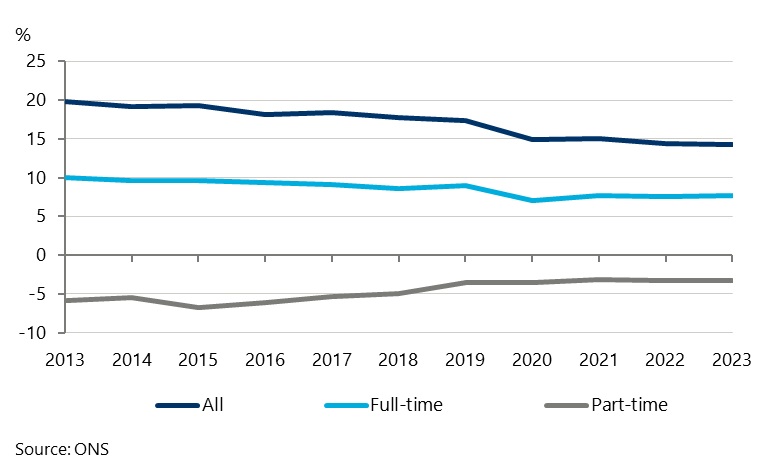Blog | 08 Mar 2024
International Women’s Day: progress of the gender pay gap in the UK

Rosie Nolan
Senior Economist, Economic Footprint & Sustainability

The gender pay gap in the UK has gained publicity in recent years, but progress to reduce it has been slow. For full-time employees, there has been a narrowing in median gross hourly earnings between men and women by 2.3 percentage points since 2013 and at the current rate of change, the gap won’t close until 2051. With International Women’s Day being celebrated on the 8 March, examining the economic inclusion of women in the UK is of utmost priority.

Since 2017, employers with 250 or more employees in England, Scotland or Wales have been legally required to report their gender pay gap data. Reducing the gap in an organisation can benefit employers by attracting and retaining employees and enhances reputation for customers. However, research shows that customers are likely to react negatively when discovering a company’s gender pay gap.
A recent CIPD survey suggests that in the year ending October 2023, 17% of businesses mandated to produce a gender pay gap report had failed to do so, and a further 18% did not know if they had. Failing to report gender pay by these organisations is illegal, but will only result in reputational damage, in the form of a “late badge“. It could be argued that this is not an adequate deterrent.
In addition, a recent analysis demonstrates that for every £1 earned by a man in the UK, an equally-qualified woman with similar personal characteristics (including ethnicity) and professional background earns 90p on average. It is important to highlight that this is greater when ethnicity is not controlled for; women of Bangladeshi origin, for instance, face the greatest estimated pay penalty, earning on average 75% of what an equally-qualified white man would earn.
Some consider the metrics required by UK pay gap reporting (mean and median rates of hourly and bonus pay) crude measures that do not accurately describe the complexities in pay differentials between men and women. For example, women are less likely to ask for and receive pay rises than men, which slows down their pay progression. Additionally, more women tend to work part-time, where pay rates are lower. Government guidance advises that organisations could introduce policies that encourage salary negotiation, such as showing salary ranges, implementing transparent promotion and pay processes, and encouraging employees to take shared parental leave.
Research on the UK university sector suggests that pay transparency reduced the gender pay gap by 4.4%, driven by female employees negotiating higher wages. Further, analysis of OECD countries by the Centre for Progressive Policy demonstrates that the introduction of paid paternity leave entitlement of six weeks is associated with a decreased incidence of gender wage gaps by four percentage points.
Therefore, while publishing gender pay gap information may not fully explain the drivers in pay differences, it is clear the gap exists. Highlighting it will therefore increase visibility, which could encourage policies to continue to narrow the gap over time. As International Women’s Day remains a cornerstone of economic gender parity, emphasising the gap and the steps needed to minimise it must be high on all corporate boardrooms’ agendas.
Author

Rosie Nolan
Senior Economist, Economic Footprint & Sustainability
+4402039108167

Rosie Nolan
Senior Economist, Economic Footprint & Sustainability
London, United Kingdom
Rosie is a Senior Economist in Oxford Economics’ Economic Footprint & Sustainability Consulting team based in London. She works on economic impact assessments and has led analysis for clients including the European Tyre and Rubber Manufacturing Association, Reckitt, and Funding Circle. Rosie joined Oxford Economics from the UK Civil Service where she worked on transport appraisal for major projects at the Department for Transport. She holds a BSc in Economics from the University of Manchester and an MSc in Economics from University College London.
Tags:
You may be interested in

Post
The Socioeconomic Impacts of Employer Investments on Local Communities
A groundbreaking research program that is designed to shed new light on the topic of the socioeconomic impact of large employers entering a local community.
Find Out More
Post
The British Gas Energy Trust: Alleviating the impact of fuel poverty
Oxford Economics were commissioned by British Gas to undertake a social return on investment analysis of the British Gas Energy Trust, a charity which funds interventions to alleviate the detrimental impact of fuel poverty.
Find Out More
Post
Why companies should prioritise their employees’ wellbeing
Employment is a fundamental part of life for many and directly links to their overall feelings of satisfaction and happiness. Recent studies, such as the comprehensive research conducted by the International Labour Organization (ILO), consistently highlight the positive association between employment and subjective wellbeing—the latter being how people evaluate their own lives.
Find Out More
Post
Ride-Hailing: A Platform for Women’s Economic Opportunity in Bangladesh
In collaboration with Uber, our latest report: “Ride-Hailing: A Platform for Women’s Economic Opportunity in Bangladesh” explores the transport challenges limiting women’s economic participation in Dhaka and the role that ride-hailing can play in overcoming them.
Find Out More